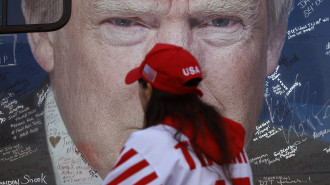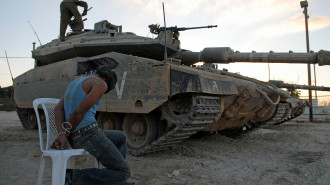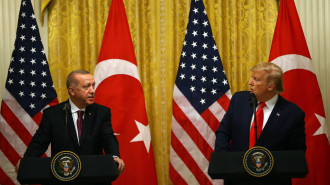
How escalating US-Iran tensions in the Middle East could play out next

The dangerous expansion of Israel’s war on Gaza into other parts of the Middle East adds new layers of violence and chaos to the region.
Without the Biden administration pressuring Israel into agreeing to a ceasefire, the war’s ripple effects will continue raising regional tensions and heightening the risk of new conflicts breaking out.
Between 17 October and 12 February, Iran-aligned actors waged 168 attacks against US military personnel stationed in Iraq, Jordan, and Syria. On 28 January, a suicide drone attack killed three US soldiers at Tower 22, a US drone base in north-eastern Jordan, which has recently been mostly used for reconnaissance missions in Iraq and Syria and operations against Iran-linked militias in those countries.
That deadly episode marked the first time in which Tehran-backed groups killed American servicemen stationed in the Middle East since Israel’s war on Gaza began last year.
Because of Iran’s relationship with these militias in Iraq and Syria, which constitute important actors in the Islamic Republic’s “axis of resistance”, President Joe Biden’s administration came under pressure from reckless hawks in the US Senate such as John Cornyn, Roger Wicker, and Lindsey Graham to retaliate by striking targets inside Iran.
"Without the Biden administration pressuring Israel into agreeing to a ceasefire, the Gaza war's ripple effects will continue raising regional tensions and heightening the risk of new conflicts breaking out"
Instead, the Biden team decided to respond to last month’s attack on Tower 22 by carrying out air and missile strikes on 2 February, hitting 85 facilities that Kataib Hezbollah and other Iran-backed actors had been using in Iraq and Syria.
Many analysts frequently refer to this tension between the US military and Iran-aligned groups in Iraq and Syria as a “proxy” war between Washington and Tehran.
Yet explaining all tensions in the region within the context of the grander US-Iran confrontation is an oversimplification.
“Recent developments are interconnected by the fact that all the so-called ‘resistance groups’ in the region receive support from Iran. However, one should also pay attention to the local context of each country involved,” said Dr Hamidreza Azizi, a visiting fellow at the German Institute for International and Security Affairs, in an interview with The New Arab.
“For example, although Iran supports the Houthi decision to escalate in the Red Sea, if the Houthis themselves had not chosen to take this action, Iran would not have had the means to force them to do so. Similarly, Iraqi groups, as part of the ‘axis of resistance,’ align their strategic decisions with Iran. Yet, at the tactical level, many of these groups enjoy a significant degree of autonomy,” added the Berlin-based Iran expert.
Nonetheless, even though these Iran-aligned Shia militias have been confronting the US for a long time, the Israeli war on Gaza has undoubtedly influenced the current round of tit-for-tat attacks.
“I view the current situation as an increase in the risk of conflict between Iran and the US, influenced by a variety of factors, rather than the commencement of a new phase of ‘proxy war’ between the two sides,” said Dr Azizi.
|
|
Iran's foreign policy goals
As regional tensions heat up, Tehran is taking calculated risks to pursue its objectives in the Middle East.
“One of these aims is to repair [Tehran’s] image in the Arab and Sunni world following its support for Assad in Syria,” Dr Talal Mohammad, who was an academic visitor at St. Antony’s College at the University of Oxford from 2019 to 2022, told TNA.
“Additionally, Iran seeks to demonstrate to its regional counterparts, particularly the Gulf states, that it is capable of inflicting significant damage to their interests in the event of a conflict, whether with them directly or with the US and its allies. These include countries like the UAE and Bahrain that are signatories to the Abraham Accords and are establishing strong economic and military ties with Israel.”
At the same time, the Iranians are sending important messages to different actors inside Iraq. Tehran’s message to Kurdish groups in northern Iraq is that the Islamic Republic still constitutes a “formidable and influential power capable of undermining Kurdish interests if they pursue independence or harbour any Kurdish groups deemed threatening to Iran’s security,” according to Dr Mohammad.
"Iran's leadership wants to make the US pay a huge price for maintaining its military presence in Iraq and Syria without having to bring Iran into a direct war with either the US or Israel"
“Furthermore, there is a domestic dimension to this ‘proxy war’. Since 1979, the issues of Palestine and portraying the US as a ‘global oppressor’ have been fundamental tenets of Tehran's ideology. Therefore, these tit-for-tat attacks serve to reassure the Iranian populace that the Islamic Republic, particularly the [Islamic Revolutionary Guard Corps], remains strong, especially amidst domestic protests and the international media coverage they garner.”
Iran’s leadership wants to make the US pay a huge price for maintaining its military presence in Iraq and Syria without having to bring Iran into a direct war with either the US or Israel.
“Instead of direct confrontation, Iran is likely to continue utilising its regional proxies to exert pressure on the US and its allies. This strategy aims to either compel the US to withdraw from Iraq or to force negotiations that lead to a significant reduction in US troop presence. By maintaining a delicate balance between escalation and de-escalation, Iran seeks to advance its interests while avoiding a full-scale regional conflict,” explained Dr Mohammad in a TNA interview.
Yet, there is good reason to doubt that Tehran will succeed in helping to create conditions in Iraq and Syria that result in Washington pulling US forces out of these two countries.
“I do not believe the withdrawal of American forces from Iraq and Syria is imminent. In Iraq, only the Shia factions close to Iran advocate for the US withdrawal, whereas Sunni factions and Kurds consider the presence of the United States essential for maintaining the balance of political power within Iraq and as a guarantee of their survival and relevance,” Dr Azizi told TNA.
“In Syria, despite continued attacks against US positions, there are no signs of the United States' willingness to withdraw its forces. In fact, the United States may even decide to reinforce its positions in Syria to curtail the freedom of action of Iran-backed militias at the Syrian-Iraqi border.”
The outcome of this year’s US presidential election could have an impact on the status of American military forces in Iraq and Syria. Dr Mehran Kamrava, a professor of government at Georgetown University in Qatar, believes that these US forces will not be withdrawn with Biden in the Oval Office. But if Donald Trump has a second term, the picture could be quite different.
“Joe Biden appears to be highly ideological in assuming a military role for the US globally and in specific relation to the Middle East. Donald Trump, however, seemed somewhat more pragmatic and reluctant to use the US military in circumstances that required prolonged military commitment,” he told TNA.
|
|
Taking advantage of chaos
The 45-year-old Islamic Republic has spent decades exploiting chaos in the Middle East. This is not chaos that the Iranians necessarily create, but Tehran is skilled at taking advantage of it.
While the US seeks to avoid being bogged down in quagmires, Iran excels at capitalising on such quagmires that trap other powers. Historic examples have included the Israeli occupation of southern Lebanon from 1982-2000, the US occupation of Iraq from 2003-11, and the Saudi war in Yemen beginning in 2015.
In all those cases, Iran managed to make adversaries bleed very slowly through Tehran’s allies, partners, and surrogates in the region.
“Contained chaos is very useful to Iran, but the United States is going to work to restore order and the sense of stability in the region,” Dr Hussein Ibish, a senior resident scholar at the Arab Gulf States Institute in Washington, told TNA. “[The Americans] have a lot of important allies in that task, although the Israeli government is one of the biggest obstacles, with its intransigence and obstinacy with regard to Palestinian human and national rights.”
Both Washington and Tehran seek to avoid a wider regional conflict, therefore such a scenario is unlikely to unfold. “But Washington would be the primary beneficiary of a perceived gradual return to calm and order, while Tehran benefits greatly from contained…chaos, which it is trying to manipulate and control,” added Dr Ibish.
"It is still too early to confidently predict whether the region's current set of crises will ultimately lead to Iran's hand in the Middle East either strengthening or weakening"
A key question now is whether this intensifying US-Iran “proxy” war in Iraq and Syria will see Iran emerge as a stronger regional power. Some analysts doubt that this will be the case and think that Iran is, to some extent, shooting itself in the foot by becoming so invested in its confrontations with the US in Iraq, Syria, and elsewhere.
“None of the military flareups Iran has instigated, including targeting members of the US armed forces in Jordan, would make the Islamic Republic stronger or safer. There’s nothing for Tehran to gain from these regional escapades, and it will only end up reproducing the perception among the neighbouring states and their people that [Iran] is a counter-productive force stymieing peace and security,” Kourosh Ziabari, an award-winning journalist from Iran, told TNA.
“Even from a military perspective, Iran is squandering its resources and money by instigating gratuitous conflicts that are not even contributing to its broader, longer-term defence agenda, and by continuing to pour missiles and drones into the arsenals of Russia, which has been proven time and again is the least trustworthy partner for the Islamic Republic,” argued Ziabari.
Some experts believe that it is still too early to confidently predict whether the region’s current set of crises will ultimately lead to Iran’s hand in the Middle East either strengthening or weakening.
“On one hand, the Gaza war demonstrated significant coordination among ‘resistance groups’ supported by Iran, marking the first time this conflict served as a platform for the realisation of the ‘unity of the fronts’ concept. However, the increasing engagement of these groups with the United States has raised the risk for Iran of being directly targeted by the US. Should such a scenario unfold, leading to a war between Iran and the United States, the repercussions for Iran would undoubtedly be devastating,” said Dr Azizi in a TNA interview.
“The overall atmosphere in the region remains exceedingly fragile, with the risk of conflict persisting at a high level. Whether Iran can emerge stronger will also depend on the outcome of the war in Gaza and the future status of Iran's allies in Lebanon, Iraq, Syria, and Yemen,” he added.
“The connection between tit-for-tat attacks between the two sides and Iran’s regional position is difficult to determine. More specifically, the degree to which US attacks will degrade the capabilities of Iran-aligned groups, the possible elimination of capable commanders, and cost-benefit analyses by Tehran concerning the viability of continued support for proxy groups are likely to be key factors,” Dr Kamrava said.
|
|
The nuclear file
Iran stands to benefit from international focus turning away from Iranian nuclear activities, with all eyes on the Gaza war and its spillover effects into other parts of the Middle East.
“Iran is making considerable progress towards nuclear weapons power status under the cover of this conflict, with very little international attention focused on these achievements because the various crises prompted by the 7 October attack are, or at least appear to be, more immediately urgent,” Dr Ibish told TNA.
“It is very possible that Iran will emerge from this crisis in much the same strategic position as it began, except it is making progress towards nuclear power status and potential weaponisation at some future date. In that sense, as long as its nuclear progress is not reversed, Iran will have made some significant advances just because international attention has been shifted to Gaza and the other flashpoints rippling out of that conflict.”
Giorgio Cafiero is the CEO of Gulf State Analytics.
Follow him on Twitter: @GiorgioCafiero









 Follow the Middle East's top stories in English at The New Arab on Google News
Follow the Middle East's top stories in English at The New Arab on Google News


